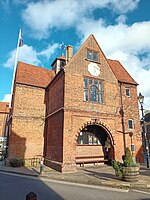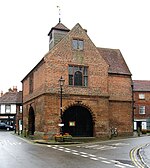Watlington railway station (Oxfordshire)

Watlington railway station in Oxfordshire was the terminus of the Watlington and Princes Risborough Railway and opened in 1872. Watlington station was not in Watlington itself, but in the parish of Pyrton half a mile from Watlington. The line was always single track. The facilities at Watlington station included a stone-built passenger building, a goods shed, and locomotive and carriage sheds. The line was projected to be extended to Wallingford, where it would complete a cross-country line between Cholsey and Princes Risborough. Due to financial difficulties the Watlington - Wallingford section was never built. British Railways closed the Watlington and Princes Risborough Railway to passengers in 1957 and to goods in 1961. Remains of the buildings exist, heavily overgrown, on private land.
Excerpt from the Wikipedia article Watlington railway station (Oxfordshire) (License: CC BY-SA 3.0, Authors, Images).Watlington railway station (Oxfordshire)
Station Road, South Oxfordshire
Geographical coordinates (GPS) Address Nearby Places Show on map
Geographical coordinates (GPS)
| Latitude | Longitude |
|---|---|
| N 51.6511 ° | E -0.9953 ° |
Address
Station Road
OX49 5DE South Oxfordshire
England, United Kingdom
Open on Google Maps








